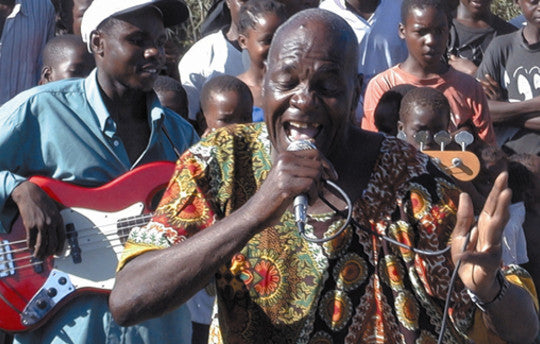Your Cart is Empty

A luta Continua (Portuguese for “the struggle continues”) was the slogan of the struggle for Mozambican independence. Mozambican music, however, has thrived since independence, and ranges from giant timbila orchestras to the salsa-inflected groove or marrabenta, from oil-can guitars through hip-hop to the phenomenon of Maputo jazz-fusion.
Timbila is the music of the Chopi people of Inhambane- a highly developed and sophisticated music played on the mbila (pural timbila),a type of xylophone.Timbila range in size from four-key bass chinzumana (or chikulu)to the eighteen-or nineteen-key high-pitched sanje (or chilanzane),with resonators made from masaalaor pumpkin gourds. A unique buzzing sound is produced by a plastic (originally animal intestine) membrane placed over a hole in the gourd.
The spellbinding music of Venancio Mbande and his timbila orchestra of around fifteen dancers and as many singers can be heard most Sunday afternoons at his house in Zavala, Inhambane Province.
Mozambique’s main urban dance rhythm, was born during the colonial period as a result of external musical influences. Marrabenta music shares certain similarities with Latin American calypso and salsa, and Angolan merengue.
During the early years of this music Marrabenta composers used native languages and played simple, repetitive rhythms. The “Kings of Marrabenta” of this era include Fany Pfumo, Dilon Djindi, Lisboa Matavel, Xidimingwana and Maekwana. In the immediate post-independence period a number of Mozambican artists living outside the country returned, bringing with them new influences.
The past fifteen years has seen the development of a distinctive form of Mozambican jazz-fusion, often involving traditional instruments. The diversity of Mozambican culture (with strong Arab, Brazilian, Portuguese and West African influences, together with influences from neighbouring countries) makes fusion a natural form of expression.
Traditional rhythms played on traditional instruments can still be heard in the rural areas of Mozambique. They’re kept alive by new migrants as well as cultural groups such as the Companhia Nacional de Canto e Dança (National Song and Dance Ensemble).
Orchestra Marrabenta Star de Moçambique, formed in 1979, was the first group to play top-quality marrabenta music and take it on tour to Europe. The group played an important role in nurturing many of the country’s current stars.
The rise of hip-hop has been one of the most exciting recent developments in Mozambican music. Beira, Mozambique’s second city, has produced groundbreaking hip-hop act Djovana, it’s leading bands, Djaaka and Musodji, play a style of music closer to Zimbabwean chimurenga than to marrabenta.
Some of the country’s best jazz musicians are now based in Johannesburg-such as guitarist Jimmy Dludlu and drummer Frank Paco. The prominent Cape Town fusion group Tucan Tucan features Mozambicans Tony Paco, Ivan Mazuze and Helda Gonzaga, and combines elements of African music with Latin rhythms and Spanish, Portuguese and English lyrics.
One of the most significant Mozambican musicians living abroad was bassist and composer Gito Baloi, who became popular after performing and releasing albums with the South African trio Tananas.
 Zena Bacar, the 'golden voice of Mozambique', is back with the return of Eyuphuro. After years of silence the original band members have reformed with other talented artists. Together with songwriter and singer Issufo Manuel, Bacar has written new songs full of melancholy and powerfull rhythm to create the long-awaited comeback album, Yellela.
Zena Bacar, the 'golden voice of Mozambique', is back with the return of Eyuphuro. After years of silence the original band members have reformed with other talented artists. Together with songwriter and singer Issufo Manuel, Bacar has written new songs full of melancholy and powerfull rhythm to create the long-awaited comeback album, Yellela.
You can now study these genres through our partner site World Music Method. Click HERE to view the list of courses.